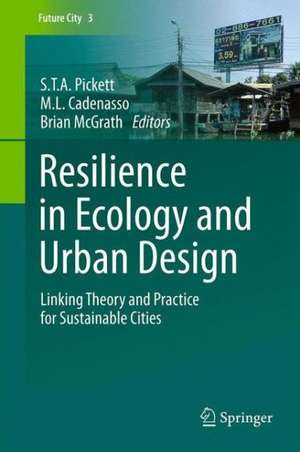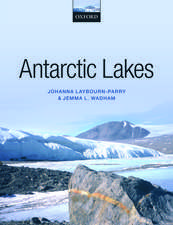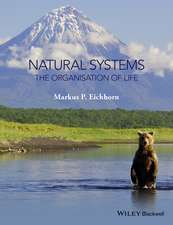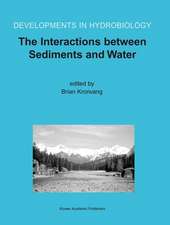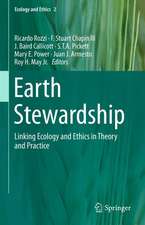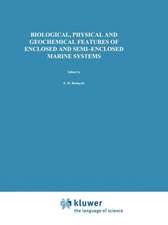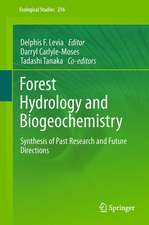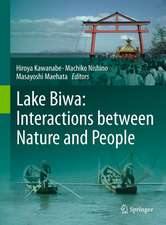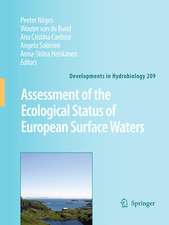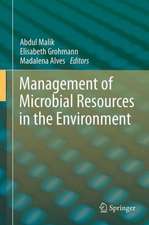Resilience in Ecology and Urban Design: Linking Theory and Practice for Sustainable Cities: Future City, cartea 3
Editat de S.T.A. Pickett, M.L. Cadenasso, Brian McGrathen Limba Engleză Hardback – 12 ian 2013
The complexity of urban areas results from their spatial heterogeneity, their intertwined material and energy fluxes, and the integration of social and natural processes. All of these features can be altered by intentional planning and design. The complex, integrated suite of urban structures and processes together affect the adaptive resilience of urban systems, but also presupposes that planners can intervene in positive ways. As examples accumulate of linkage between sustainability and building/landscape design, such as the Shanghai Chemical Industrial Park and Toronto’s Lower Don River area, this book unites the ideas, data, and insights of ecologists and related scientists with those of urban designers. It aims to integrate a formerly atomized dialog to help both disciplines promote urban resilience.
| Toate formatele și edițiile | Preț | Express |
|---|---|---|
| Paperback (1) | 1391.67 lei 6-8 săpt. | |
| SPRINGER NETHERLANDS – 12 ian 2013 | 1391.67 lei 6-8 săpt. | |
| Hardback (1) | 1243.29 lei 6-8 săpt. | |
| SPRINGER NETHERLANDS – 12 ian 2013 | 1243.29 lei 6-8 săpt. |
Din seria Future City
-
 Preț: 330.09 lei
Preț: 330.09 lei - 15%
 Preț: 641.85 lei
Preț: 641.85 lei - 18%
 Preț: 958.73 lei
Preț: 958.73 lei - 18%
 Preț: 966.27 lei
Preț: 966.27 lei - 24%
 Preț: 622.86 lei
Preț: 622.86 lei - 23%
 Preț: 846.66 lei
Preț: 846.66 lei - 24%
 Preț: 784.53 lei
Preț: 784.53 lei - 23%
 Preț: 567.54 lei
Preț: 567.54 lei -
 Preț: 371.97 lei
Preț: 371.97 lei - 19%
 Preț: 553.68 lei
Preț: 553.68 lei - 24%
 Preț: 871.40 lei
Preț: 871.40 lei - 24%
 Preț: 833.99 lei
Preț: 833.99 lei - 18%
 Preț: 954.14 lei
Preț: 954.14 lei - 18%
 Preț: 949.42 lei
Preț: 949.42 lei - 18%
 Preț: 1114.83 lei
Preț: 1114.83 lei - 18%
 Preț: 950.21 lei
Preț: 950.21 lei - 15%
 Preț: 647.59 lei
Preț: 647.59 lei - 20%
 Preț: 516.79 lei
Preț: 516.79 lei - 24%
 Preț: 897.11 lei
Preț: 897.11 lei
Preț: 1243.29 lei
Preț vechi: 1516.21 lei
-18% Nou
Puncte Express: 1865
Preț estimativ în valută:
237.91€ • 249.02$ • 198.01£
237.91€ • 249.02$ • 198.01£
Carte tipărită la comandă
Livrare economică 31 martie-14 aprilie
Preluare comenzi: 021 569.72.76
Specificații
ISBN-13: 9789400753402
ISBN-10: 9400753403
Pagini: 528
Ilustrații: XXVI, 499 p. 182 illus., 127 illus. in color.
Dimensiuni: 155 x 235 x 34 mm
Greutate: 1.18 kg
Ediția:2013
Editura: SPRINGER NETHERLANDS
Colecția Springer
Seria Future City
Locul publicării:Dordrecht, Netherlands
ISBN-10: 9400753403
Pagini: 528
Ilustrații: XXVI, 499 p. 182 illus., 127 illus. in color.
Dimensiuni: 155 x 235 x 34 mm
Greutate: 1.18 kg
Ediția:2013
Editura: SPRINGER NETHERLANDS
Colecția Springer
Seria Future City
Locul publicării:Dordrecht, Netherlands
Public țintă
Professional/practitionerCuprins
1. Ecology of the City as a Bridge to Urban Design.- 2. Three Tides: The Development and State of the Art of Urban Ecological Science.- 3. Social Dynamics and Sustainable Urban Design.- 4. Integral Urbanism: A Context for Urban Design.- 5. Landscape as Method and Medium for the Ecological Design of Cities.- 6. Ecological Heterogeneity in Urban Ecosystems: Reconceptualized Land Cover Models as a Bridge to Urban Design.- 7. Urban Patch Dynamics and Resilience: Three London Urban Design Ecologies.- 8. Eco-engineering for Water: From Soft to Hard & Back.- 9. Beyond Restoration and into Design: Hydrologic Alterations in Aridland Cities.- 10. Ecological Resilience as a Foundation for Urban Design and Sustainability.- 11. Slow, Moderate, Fast: Urban Adaptation and Change.- 12. Anchoring a Terrain: Landscapes beyond Urbanism.- 13. Storyline and Design: How Civic Stewardship Shapes Urban Design in New York City.- 14. Eco-cities without Ecology: Constructing Ideologies, Valuing Nature.- 15. Sponge City.- 16. Civic Space in Regional Frameworks: Resilient Approaches to Urban Design.- 17. Aesthetic Resilience.- 18. Anchoring Philadelphia.- 19. Shanghai Chemical Industrial Park Treatment Wetland: Integrated Strategies in Natural Treatment System Design.- 20. Just Ground: A Social Infrastructure for Urban Landscape Regeneration.- 21. Ecological and Social Linkages in Urban Design Projects: A Synthesis.- 22. The Design Process as a Framework for Collaboration between Ecologists and Designers.- 23. Remixing Messages: A Call for Collaboration between Artists and Scientists.- 24. Landscape Urbanism: A North American Perspective.- 25. Urbanism and Ecological Rationality.- 26. Bangkok: The Ecology and Design of an Aqua-City.- 27. Disturbanism in the South Pacific: Disturbance Ecology as a Basis for Urban Resilience in Small Island States.- 28. The Ecology of the Metacity: Shaping the Dynamic, Patchy, Networked, and Adaptive Cities of the Future.
Textul de pe ultima copertă
The contributors to this volume propose strategies of urgent and vital importance that aim to make today’s urban environments more resilient. Resilience, the ability of complex systems to adapt to changing conditions, is a key frontier in ecological research and is especially relevant in creative urban design, as urban areas exemplify complex systems. With something approaching half of the world’s population now residing in coastal urban zones, many of which are vulnerable both to floods originating inland and rising sea levels, making urban areas more robust in the face of environmental threats must be a policy ambition of the highest priority.
The complexity of urban areas results from their spatial heterogeneity, their intertwined material and energy fluxes, and the integration of social and natural processes. All of these features can be altered by intentional planning and design. The complex, integrated suite of urban structures and processes together affect the adaptive resilience of urban systems, but also presupposes that planners can intervene in positive ways. As examples accumulate of linkage between sustainability and building/landscape design, such as the Shanghai Chemical Industrial Park and Toronto’s Lower Don River area, this book unites the ideas, data, and insights of ecologists and related scientists with those of urban designers. It aims to integrate a formerly atomized dialog to help both disciplines promote urban resilience.
The complexity of urban areas results from their spatial heterogeneity, their intertwined material and energy fluxes, and the integration of social and natural processes. All of these features can be altered by intentional planning and design. The complex, integrated suite of urban structures and processes together affect the adaptive resilience of urban systems, but also presupposes that planners can intervene in positive ways. As examples accumulate of linkage between sustainability and building/landscape design, such as the Shanghai Chemical Industrial Park and Toronto’s Lower Don River area, this book unites the ideas, data, and insights of ecologists and related scientists with those of urban designers. It aims to integrate a formerly atomized dialog to help both disciplines promote urban resilience.
Caracteristici
Communicates sound, up-to-date ecological principles to the urban design community to help improve the ecological function of designed and built landscapes Identifies novel environmental research directions needed to support basic urban ecology as well as sustainable and resilient urban design Articulates new criteria for assessing good ecological urban design while engaging the design imagination Contributions by leading voices in the design and ecological communities Includes supplementary material: sn.pub/extras
